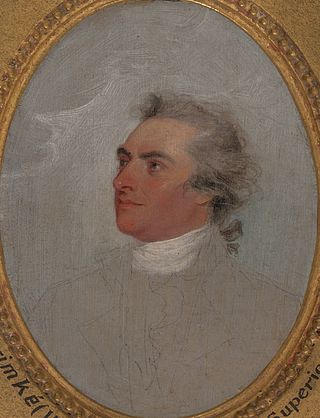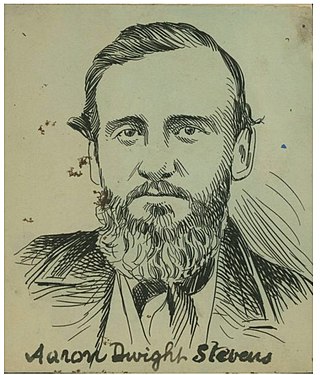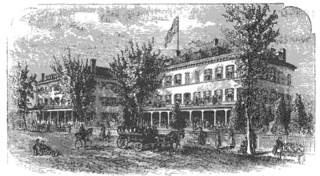
The Raritan Bay Union was a utopian community in Perth Amboy, New Jersey, active from 1853 until 1860.

The Raritan Bay Union was a utopian community in Perth Amboy, New Jersey, active from 1853 until 1860.
Raritan Bay Union the community was started by Marcus Spring and his wife Rebecca Buffum Spring (1811–1911). [1]
Theodore Dwight Weld was in charge of the connected boarding school, active from 1854 until c. 1861. [1] [2]
Maud Honeyman Green writes, "The Union established a progressive boarding school that was a pioneer in co-education. Girl students were encouraged to speak in public, engage in sports, and act in plays, activities that were frowned upon in other schools. Abolitionists Angelina Grimké and Sarah Moore Grimké were teachers in the school, which was run by Angelina’s husband, Theodore D. Weld. Several other noted reformers came to teach and lecture at the school. The Welds’ school operated until about 1861."[ citation needed ]
Others who lived at Raritan Bay Union included Charles Kingsley, Caroline Kirkland, and James G. Birney. [3] [ failed verification ] The early women's rights activist Clarina I. H. Nichols left her two youngest children at Raritan Bay Union when she set out with the New England Emigrant Aid Company for Kansas Territory in 1855. [4]

Theodore Dwight Weld was one of the architects of the American abolitionist movement during its formative years from 1830 to 1844, playing a role as writer, editor, speaker, and organizer. He is best known for his co-authorship of the authoritative compendium American Slavery as It Is: Testimony of a Thousand Witnesses, published in 1839. Harriet Beecher Stowe partly based Uncle Tom’s Cabin on Weld's text; the latter is regarded as second only to the former in its influence on the antislavery movement. Weld remained dedicated to the abolitionist movement until slavery was ended by the Thirteenth Amendment to the United States Constitution in 1865.

Angelina Emily Grimké Weld was an American abolitionist, political activist, women's rights advocate, and supporter of the women's suffrage movement. She and her sister Sarah Moore Grimké were considered the only notable examples of white Southern women abolitionists. The sisters lived together as adults, while Angelina was the wife of abolitionist leader Theodore Dwight Weld.
The Wyandotte Constitution is the constitution of the U.S. state of Kansas.

Sarah Moore Grimké was an American abolitionist, widely held to be the mother of the women's suffrage movement. Born and reared in South Carolina to a prominent, wealthy planter family, she moved to Philadelphia, Pennsylvania, in the 1820s and became a Quaker, as did her younger sister Angelina. The sisters began to speak on the abolitionist lecture circuit, joining a tradition of women who had been speaking in public on political issues since colonial days, including Susanna Wright, Hannah Griffitts, Susan B. Anthony, Elizabeth Cady Stanton, and Anna Dickinson. They recounted their knowledge of slavery firsthand, urged abolition, and also became activists for women's rights.

Sarah Moore Grimké (1792–1873) and Angelina Emily Grimké (1805–1879), known as the Grimké sisters, were the first nationally-known white American female advocates of abolition of slavery and women's rights. They were speakers, writers, and educators.

Archibald Henry Grimké was an African American lawyer, intellectual, journalist, diplomat and community leader in the 19th and early 20th centuries. He graduated from freedmen's schools, Lincoln University in Pennsylvania, and Harvard Law School and served as American Consul to the Dominican Republic from 1894 to 1898. He was an activist for rights for blacks, working in Boston and Washington, D.C. He was a national vice-president of the National Association for the Advancement of Colored People (NAACP), as well as president of its Washington, D.C. branch.

The Eagleswood Military Academy was a private military academy in Perth Amboy, in Middlesex County, New Jersey, United States, which served antebellum educational needs.

The North American Phalanx was a secular utopian socialist commune located in Colts Neck Township, Monmouth County, New Jersey. The community was the longest-lived of about 30 Fourierist Associations in the United States which emerged during a brief burst of popularity during the decade of the 1840s.

Francis James Grimké was an American Presbyterian minister in Washington, DC. He was regarded for more than half a century as one of the leading African-American clergy of his era and was prominent in working for equal rights. He was active in the Niagara Movement and helped found the National Association for the Advancement of Colored People (NAACP) in 1909.
Marcus Spring was, with his wife Rebecca Buffum Spring, the creator of the Raritan Bay Union, a utopian community in Perth Amboy, New Jersey.

John Faucheraud Grimké was an American jurist who served as Associate justice and Senior Associate Justice of South Carolina's Court of Common Pleas and General Sessions from 1783 until his death. He also served in the South Carolina state legislature from 1782 until 1790. He was intendant (mayor) of Charleston, South Carolina, for two terms, from 1786 to 1788.

Aaron Dwight Stevens was an American abolitionist. The only one of John Brown's raiders with military experience, he was the chief military aide to Brown during his failed raid on the federal arsenal in Harpers Ferry, Virginia. For his role in the raid, Stevens was executed on March 16, 1860. He was 29.

Mount Hope Cemetery is a historic cemetery in southern Boston, Massachusetts, between the neighborhoods of Roslindale and Mattapan.
Rachel is a play that was written in 1916 by African American teacher, playwright and poet Angelina Weld Grimké. Grimké submitted the play to the Drama Committee of the National Association for the Advancement of Colored People (NAACP). For the first production of the play the program read: "This is the first attempt to use the stage for race propaganda in order to enlighten the American people relative to the lamentable condition of the millions of Colored citizens in this free republic."

American Slavery as It Is: Testimony of a Thousand Witnesses is a book written by the American abolitionist Theodore Dwight Weld, his wife Angelina Grimké, and her sister Sarah Grimké, which was published in 1839.
The Massachusetts Woman Suffrage Association (MWSA) was an American organization devoted to women's suffrage in Massachusetts. It was active from 1870 to 1919.

The National Abolition Hall of Fame and Museum is a museum located in Peterboro, New York, that honors American abolitionists by showcasing their work to end slavery, and the legacy of their struggle: the drive to end racism.

Dr. Dio Lewis's School for Young Ladies was an American boarding school for young women. Founded in 1864 by Dr. Diocletian Lewis, it was located at the Lexington House, at Lexington, Massachusetts. The building was burned down on September 7, 1867. This was the first institution for young ladies in the United States in which a determined and successful attempt was made to combine a thorough scientific physical training with a broad and complete intellectual and moral culture. His object was to illustrate the possibilities in the physical development of girls during their school life.
Rebecca Buffum Spring was a Quaker abolitionist, educational reformer, feminist, and women's suffrage activist. She was born in Providence, Rhode Island, fourth daughter of Arnold Buffum (1782-1859), who with William Lloyd Garrison founded the New England Anti-Slavery Society, of which he was the first president. Elizabeth ended her education at the age of 16 and became a teacher in an infant school at the request of her father. Elizabeth Buffum Chace was her sister. She was co-founder in 1836 of the Fall River Female Anti-Slavery Society.
Harriet Purvis Jr. also known as Hattie Purvis was an African-American abolitionist, suffragist and a member of the temperance movement. She was part of the second generation of American suffragists. Purvis worked closely with Susan B. Anthony.